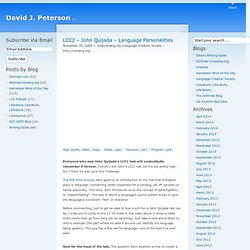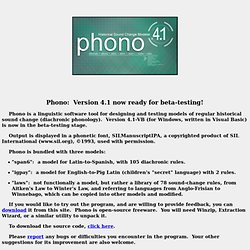

Gallifreyan Academy - Learn. Constructed Languages for Language Geeks. Musings about constructed languages. » 2009 » November David J. Peterson. Everyone who saw John Quijada’s LCC1 talk will undoubtedly remember it forever.

I know I will. John’s LCC1 talk set the bar pretty high, but I think he was up to the challenge. The first time around, John gave us an introduction to the role that metaphor plays in language—something vitally important for a conlang, yet oft ignored (or tacitly assumed). This time, John introduces us to the concept of Sprachgefühl, or “Speechfeeling”: The way in which a language’s sound system works to give the language a consistent “feel” or character. Before commenting, just to get an idea of how much fun a John Quijada talk can be, I urge you to jump to the 11:30 mark in the video above (I know a video that’s more than an hour long can be daunting). Unspeakableness. Investigation in Emotion Classification This is the early stage research of the project.

In late January, 2012, I emailed around Royal College of Art asking for words describing emotions in languages other than English that are untranslatable into English. Universal Language Dictionary 2.7. The lexical treasures of m. john harrison. M.

Making Languages (because there aren't enough) The Correspondence Library - KneeQuickie. From /p,t,k/ to 'Potake' by Jessie Sams on Prezi. Conlang. Conlanging is the art of creating languages. People create languages — conlangs — for all sorts of reasons: practical, theoretical, and artistic. This book will show you how. There are three parts, each aimed at a different level of experience; they are intended to be read in order, but more proficient readers may skip earlier sections. The Beginner level takes you through the steps of creating a conlang, without a lot of technical details or technical terms. With the help of this level, you can create an interesting conlang that doesn't accidentally copy the sound and feel of your native language.The Intermediate level takes you through the parts of a language, avoiding really esoteric technical details and terms, but providing a systematic working knowledge of the building blocks from which conlangs are made.
LEE HARTMAN'S LANGUAGE RESOURCES. Phono: Version 4.1 now ready for beta-testing!

Phono is a linguistic software tool for designing and testing models of regular historical sound change (diachronic phonology). Version 4.1-VB (for Windows, written in Visual Basic) is now in the beta-testing stage. Output is displayed in a phonetic font, SILManuscriptIPA, a copyrighted product of SIL International (www.sil.org), ©1993, used with permission. Inspirational Natlangs - FrathWiki. From FrathWiki With a little digging, one can easily find quite a selection of freely-available grammars on the web. Normally I just download these and dump them into my e-reader, but then if I want to direct someone else to a grammar, I have to go hunting again. It seemed useful to make a list. Theiling Online: (Con)Language Resources. Constructed Languages for Language Geeks. Publications - barriemichael. 2012 “Antisymmetry and Dynamic Antisymmetry,” in Language and Linguistics Compass 61): 21-35. 2012 (with Éric Mathieu) “Head Movement and Noun Incorporation,” in Linguistic Inquiry 43(1): 133-142. 2011 Dynamic Antisymmetry and the Syntax of Noun Incorporation.
Dordrecht: Springer.2010. Prumin Tulvan siv. Acta Lingweenie. Katanik κατὰ Νικ. Kareyku. Konyalanguage : Message: Semantic categories of root words, and part-of-speech conversion. I've thought some more about how we decide what the noun meaning of a word must probably be, if we know its verb meaning, or vice versa.

Rene de Saussure came up with the theory of three semantic categories for root words in Esperanto, which was later elaborated by Kalocsay and Waringhien - something like this: 1. substantial (the noun form is the primary meaning, others are derived from it. adj = related to, made of, this thing; verb = to be this thing; to be made of this stuff; to use this tool; or one of several other derivations) 2. quality (the adjective form is the primary meaning, others are derived from it: noun = this quality in the abstract, verb = to have this quality) 3. action (the verb form is the primary meaning, others are derived from it; noun = act of doing this action, adj = related to the action)
LISTSERV 16.0 - CONLANG Archives. Graded Sentences for Analysis. Ainu Grammar. 1.

--In writing the Ainu language with the Roman letters, the following system has been adopted:-- LETTERS. Pronunciation and Remarks. a As a in the word “father”.e As e in the word “benefit”.i As i in the word “ravine”.o As o in the word “mote”.u As u in the word “rule”.ai As ai in the word “aisle” or i in “ice”.ei As ey in the word “they”.ao, au, eo, eu, ou are combinations in which each vowel must be distinctly pronounced.b As b in English. No sentence can commence with this letter; but, preceded by another word, the letter p is often changed into b.c This letter is never heard except in the combination ch.
Random phonology.